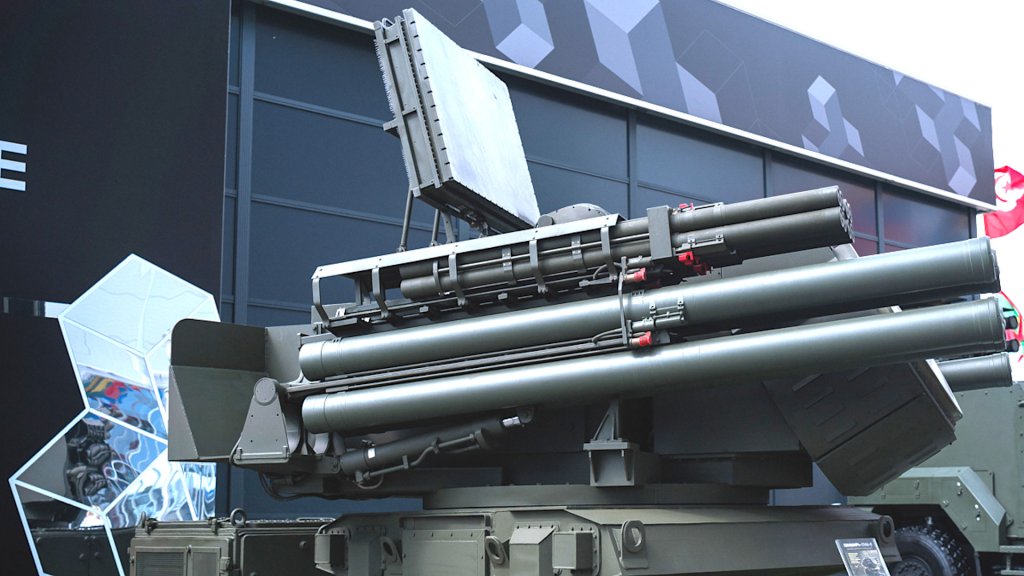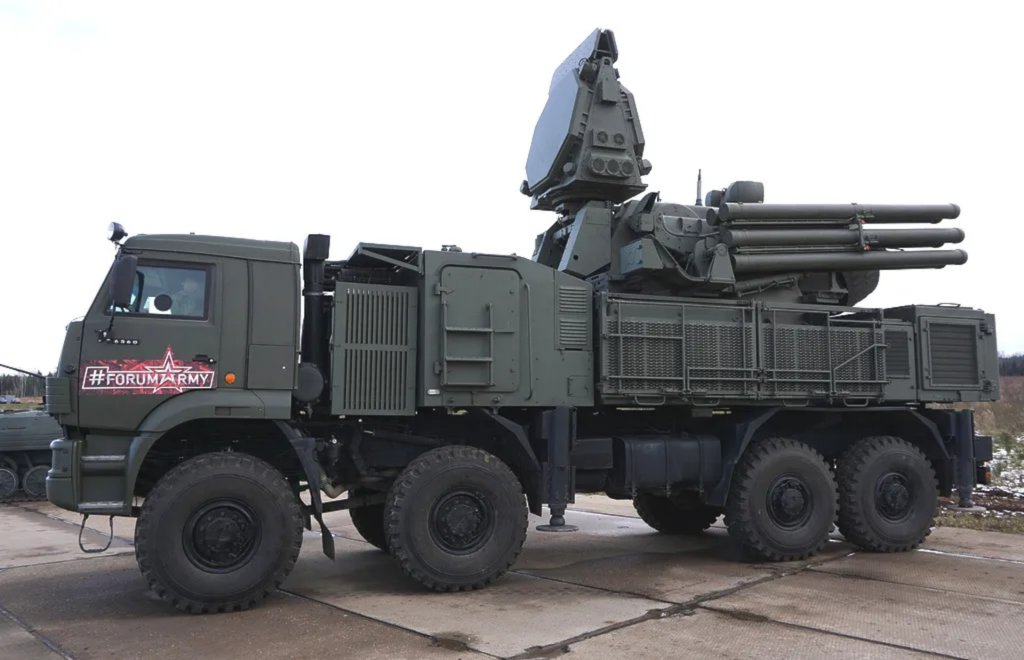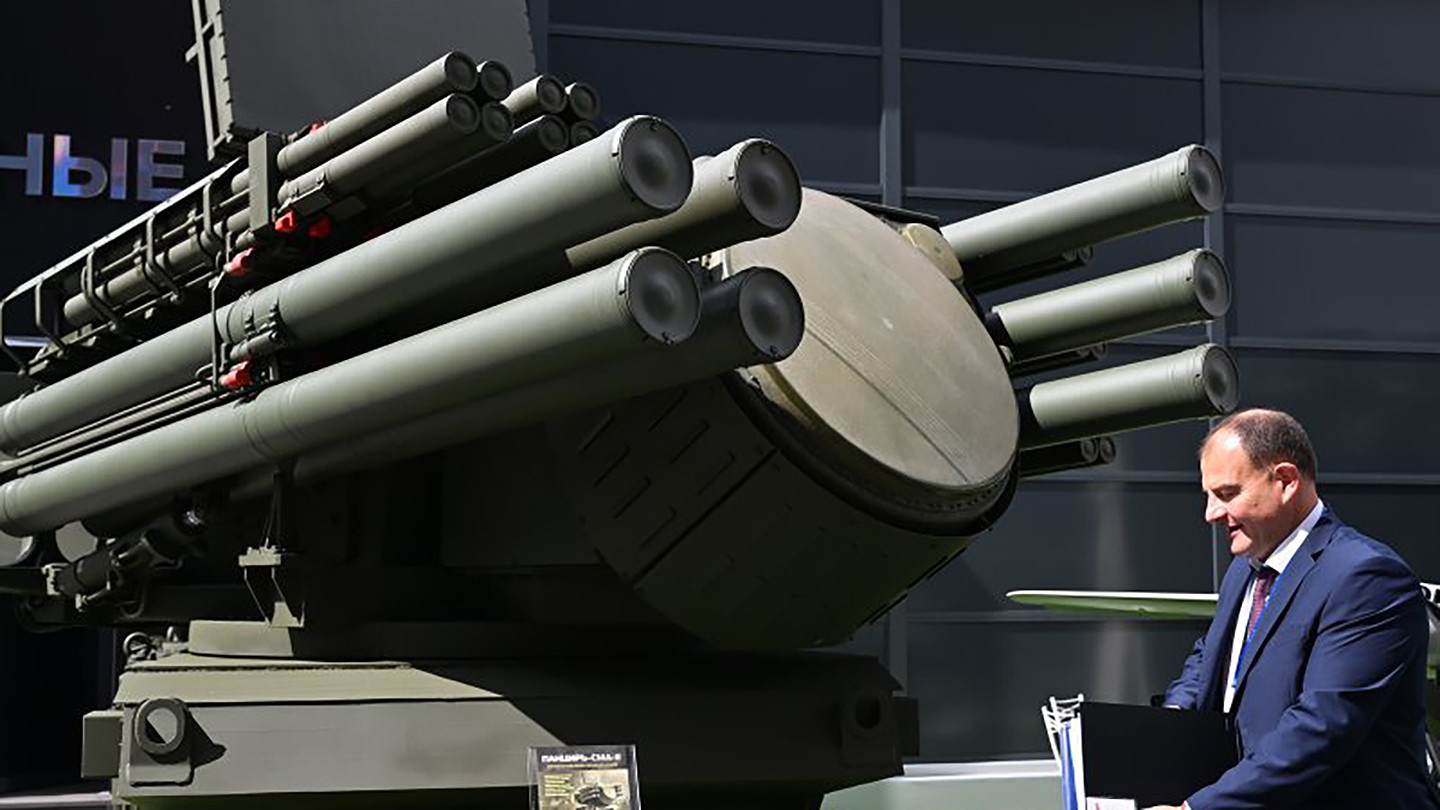Russia has announced a new variant of its Pantsir short-range air defense system that can be loaded with as many as 48 small interceptors and that it says is specifically intended to help shield critical infrastructure from uncrewed aerial threats. For some time now, Ukrainian forces have been launching increasingly longer-range drone attacks on military bases and industrial facilities inside Russia.

The Pantsir-SMD-E made its debut at the Army 2024 exhibition, which opened at the Patriot Park in Kubinka outside of Moscow yesterday. The SMD-E variant was shown in a self-contained static configuration, but it is not hard to imagine that it could be integrated onto various tactical trucks or other platforms, including ships, like previous Pantsir types.

The new SMD-E variant of Pantsir has a turret that can be loaded with up to 12 57E6-series short-range command-guided surface-to-air missiles, as many as 48 TKB-1055 very-short-range interceptors, or a mix thereof. The TKB-1055 is a relatively recent development focused heavily on defeating drone threats and has a stated maximum range of just over 4 miles (7 kilometers) compared to the 57E6-E’s nearly 12 and a half miles (20 kilometers), per a placard seen at Army 2024.
Like previous versions of Pantsir, the SMD-E’s turret also has two integrated radars, one for spotting and tracking targets and another fire control type for directing the command-guided missiles. Where the new variant notably differs from most of the preceding versions of the system is in its lack of gun armament.
Most ground-based Pantsir variants have turrets armed with two twin-barrel 2A38M 30mm automatic cannons, as well as up to 12 57E6-series missiles. The navalized Pantsir-M developed for installation on ships substitutes the 2A38M cannons for six-barrel 30mm AO-18KDs.


In 2022, a model of a missile-only Pantsir-SM-TBM version, able to be loaded with up to 24 57E6-series missiles at a time, emerged. The SM-TBM variant also lacked a search radar, relying instead on offboard sensors (including on other Pantsirs) for initial cueing. It is unclear how far the development of that variant has progressed.
“The Pantsir family of systems is constantly being improved and expanded. The new Pantsir-SMD-E is designed to protect stationary objects from air attack weapons, including massive drone attacks,” Bekkhan Ozdoyev, head of the “arms cluster” of Russia’s state-run Rostec defense conglomerate, said according to a machine translation of an official press release on the new Pantsir variant. “To combat these targets, the system can carry 48 short-range missiles. These are effective and inexpensive ammunition that reliably protect against small drones, and allow, figuratively speaking, not to shoot sparrows with a cannon.”
If they work as advertised, using the smaller and lower-cost TKB-1055s would offer advantages over the 57E6 family in the point-defense role, especially in terms of magazine depth. They could be even more effective combined with newer radars already introduced onto previous versions of Pantsir that are said to increase the total number of targets the system can track and engage simultaneously. Deleting the cannons and their feed systems could also reduce the SMD-E’s cost and time to manufacture compared to other versions of the system, at least to a degree. These latter points could be particularly important given the impacts of extensive U.S. and other Western sanctions on Russia’s defense industry.
At the same time, the shift away from guns seems curious given that the Ukrainian military has been routinely demonstrating that traditional anti-aircraft artillery remains an effective and low-cost tool for shooting down subsonic drones and cruise missiles, as well as other lower-flying aerial threats. In more of a direct comparison with Pantsir, Ukraine’s air defense forces have been making especially good use of German-made Gepard self-propelled anti-aircraft guns, which are armed only with a pair of radar-directed 35mm automatic cannons. Ukraine has now begun receiving newer Skynex anti-aircraft guns from Germany, as well.
The Pantsir family has already earned a very mixed reputation since its introduction in the early 2010s, especially due to reportedly poor performance in Syria and Libya. The upgraded radars found on more recent variants are said to have been developed as a direct result of lessons learned from use during operations in Syria.
Regardless, variants of the Pantsir system remain in widespread use in the Russian armed forces, including in Syria, where one fired a missile at a U.S. MQ-9 Reaper drone in 2022.
Pantsirs have also been important components of existing efforts to shield critical military, government, and industrial facilities from Ukrainian drone attacks. Last year, Pantsirs appeared on rooftops in Moscow and near one of President Vladimir Putin’s official residences just outside the capital as Ukraine stepped up its uncrewed aerial assault. These were part of a larger array of additional layered air defenses deployed in and around the Russian capital that also included extra S-400 long-range surface-to-air missile batteries.
Furthermore, the explicit focus on using Pantsir-SMD-E for point defense of critical infrastructure against drones underscores how real a danger Ukraine’s uncrewed attackers have come to pose to highly prized facilities deeper and deeper inside Russia. Uncrewed aerial systems present serious threats to Russian forces in frontline fighting in Ukraine, as well.
The routine use of uncrewed aerial systems, including multiple tiers of weaponized types, on both sides of the war in Ukraine has provided clear evidence that drone threats, which are not new, are still evolving in scale and scope. Long-range kamikaze drones look set to be a growing danger on a global level to military forces on the frontlines and critical infrastructure deeper within a country’s home territory.
“So, you know, the problem got complicated here in the last two and a half years, and the proliferation… every country, you know, can afford these kinds of things and we have to go against them,” U.S. Air Force Gen. James Hecker, his service’s top office in Europe and also NATO’s Allied Air Command, said while speaking about drone threats last month. “We can use them [as] well and put adversaries on the wrong side of the cost curve.”
So, in turn, there has been a surge of interest in counter-drone capabilities worldwide and not just to protect forces on land. As already noted, a navalized version of Pantsir already exists and ships are at ever-increasing risk of being attacked by drones, as has been highlighted by the ongoing crisis in and around the Red Sea.
It is not hard to see a maritime role for Pantsir-SMD-E, or a further anti-drone-focused version thereof. There is a certain general precedent for this already with Israel’s adaptation of the land-based Iron Dome counter-rockets, artillery, and mortars system, which also has a point defense capability against drones and cruise missiles, for use on ships. The Russian Navy has also been observed adding Tor surface-to-air missile systems to ships in an improvised manner to help bolster point air defense capabilities.
All of this might also prompt export interest in a system like Pantsir-SMD-E in countries undaunted by the prospect of Western sanctions. A foreign partner could help further defray development and acquisition costs for Russia.
It does remain to be seen how effective, or even widely fielded by Russia, Pantsir-SMD-E ends up being. Still, the new Pantsir variant reflects real and still growing concerns about the threats drones pose that extend well beyond the war in Ukraine and traditional battlefields, in general.
Contact the author: joe@twz.com
